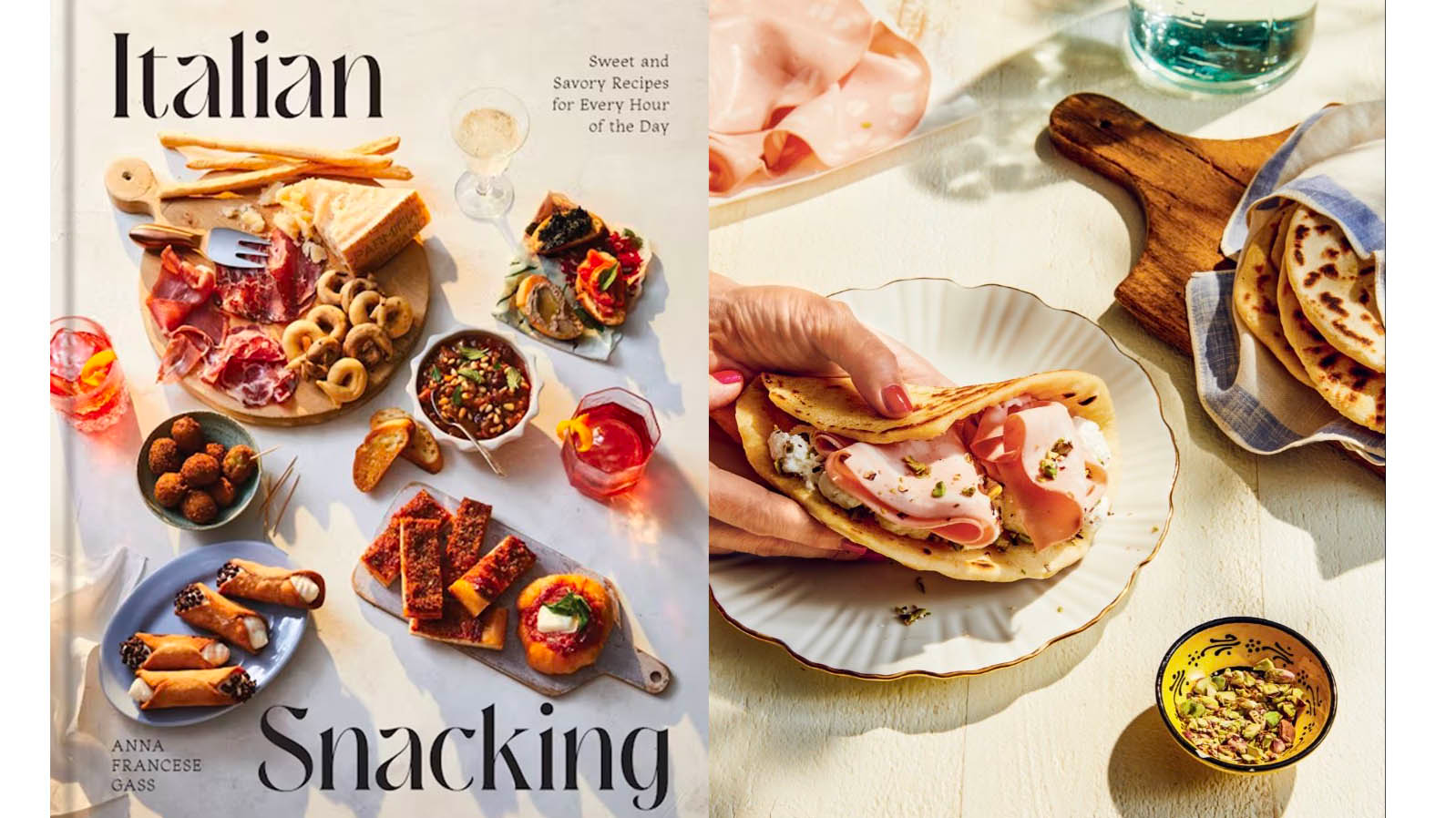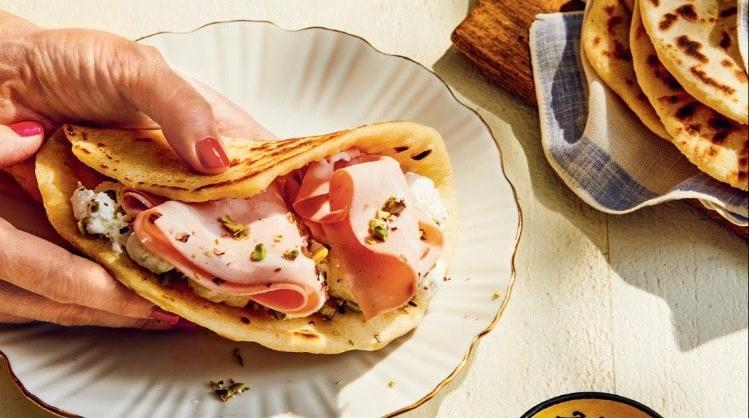Serve These Italian Snacks Instead Of Charcuterie
The Italian Snacking cookbook features sputini recipes galore.
Over the past few years, American tables have been awash in snack boards, laden with charcuterie, baked goods, butters, and even candy. But a new cookbook offers an Italian alternative to the charcuterie board: snacks, and lots of them.
In Italian Snacking, Sweet and Savory Recipes for Every Hour of the Day, which comes out March 19, author Anna Francese Gass writes about spuntini, or miniature treats that can be enjoyed in between meals.
Americans are already quite familiar with some of these foods, like bruschetta and arancini, but there are some surprises in Gass' book, which offers a number of sweet treats as well as savory ones.
A fuller view of Italian food
Many Americans think of Italian meals as having a starter, a pasta course, an entree, and a dessert. Italians do eat that way, Gass says, but mainly on Sundays or while dining out.
"What I am presenting is the day as a whole," she tells The Takeout by email. "Italians have special moments throughout the day, aside from breakfast, lunch and dinner where they will stop for a quick bite to eat, a spuntino. That is what I wanted to highlight, along with street food which is available from early morning til late at night."
To people who've traveled, some of Gass's recipes will ring a bell. For instance, spuntini di meta mattina are mid-morning snacks that are often taken with a second or third espresso. These are similar to gabel frustuck, or fork breakfast, which are eaten in Austria, or "elevenses" in England. Merenda are afternoon treats for children and adults alike—similar to the gouter (often a pain au chocolat) that French children eat. Apertivi are, no surprise, early evening bites that are eaten with drinks, like Apero hour in France.
"I have always said borders are arbitrary," Gass says. "We all influence each other. If you are in Northern Italy, you will eat so many dishes that are Austrian and French inspired. If you listen to the accent of a native Cervinian (from Valle d'Aosta), you can hear a Germanic tone to their pronunciation."
Boards, but with a twist
Although "charcuterie" is the French term for cured meats, Gass says there's a parallel in Italy: an antipasti platter is very common. "Salumi, cheeses, taralli, olives, etc. will be presented with a glass of wine or a cocktail. This book just presents a much wider option."
For instance, olive all'Ascolana are fried olives stuffed with a bit of meat. Polpettini are little meatballs that pair with a glass of wine. "The recipes in this book are convivial and very pleasing to the eye and palate," Gass says. "Very fun to make and eat. Let's say it's snacking 2.0!"
A guide to Italian snacking
Earlier in the day, sputini are more likely to be sweet, Gass says. That might mean a little slice of cake, a few biscotti, or even a dish of lemon sorbet. "In the morning, you are drinking coffee, and what goes better with coffee than a little sweet?" she says.
As the day goes on, the snacks become more savory. For happy hour or late-night snacking, "We gravitate to the salty fried bites like rice balls, pizza or even a nice skewer of meat to pair with a beer, wine or cocktail," she says.
Gass is especially fond of arancini, stuffed and lightly fried rice balls. These are a great starter to learn about Italian snackways. Her book includes recipes for a trio of arancini, one each from Sicily, Calabria, and Rome. "They are equally delicious but also highlight how, based on location, Italians have fantastic variations to their dishes," she says.
Beyond that, each region does street food slightly differently. "In Naples, you will see lots of pizza, both fried and loaded with toppings. If you are in Palermo, pizza is not as common, and instead there are lots of grilled skewers." She loves spiedini di carne, a chicken skewer stuffed with cheese and ham that is "out of this world good."
The Italian Snacking cookbook includes a pantry list. "If you come over for coffee, I will have some of my almond and anise biscotti on hand for you to dunk into your cappuccino," Gass says. If you visit in the afternoon, "I'll slice you a piece of my crostata with ricotta and sour cherry jam."
Unexpected guests popping by after work? "No problem, I'll make some my crostini (crispy bread) with spreads like caponata, olive pate or peperonata for you to munch on with a nice glass of wine. At my house, no matter the time of day, you will be well fed."
Recipe: Piadina With Mortadella, Ricotta and Pistachio
Reprinted with permission from Italian Snacking: Sweet and Savory Recipes for Every Hour of the Day © 2024 Anna Francese Gass. Published by Union Square & Co. Photography by Linda Xiao.
Piadina is the sandwich bread of Bologna. A traditional recipe does not include potato, but Gass added it to make the bread more pliable when folding it over the fillings.
Piadina
- 8 ounces Yukon Gold potatoes, peeled and cut into 1-inch cubes
- 3 1/2 cups all-purpose flour, plus more for dusting
- 2 tsp. kosher salt
- 2 tsp. baking powder
- 3 Tbsp. shortening or lard
- 1/4 cup whole milk
- Extra virgin olive oil, for brushing
Fillings
- 1 cup whole milk ricotta cheese
- 1 cup shelled pistachios, toasted and chopped
- kosher salt (optional)
- 1 pound thinly sliced mortadella
Place the potatoes in a medium pot, cover with cold water, and bring to a boil. Cook until very tender, about 12 minutes.
Reserve about 1/2 cup of the potato cooking liquid. Drain the potatoes and return them to the pot. Mash with a fork or potato ricer. Add the reserved cooking liquid and whisk to combine and smooth out any lumps. Allow to cool for 20 minutes.
In the bowl of a stand mixer fitted with a dough hook, combine the flour, salt, and baking powder. Mix at medium speed for one minute. With the machine running, drop in small pieces of shortening. Add the cold mashed potatoes and milk. Raise the speed to medium-high, and mix for about four minutes, until a loose ball is formed.
Transfer the dough to a lightly floured work surface and knead until a soft, pliable dough forms. Add flour if needed.
Roll the dough into a large log, and cut into eight equal pieces. Each piece should weigh about four ounces. Place on a baking sheet. Cover with plastic and allow it to rest for 25 to 30 minutes.
Roll each piece of dough into a ball, then flatten each into a circle about eight inches in diameter. Place a flat top griddle or a large crepe pan over medium-high heat for two minutes. Brush with a few teaspoons of oil, and reduce to medium-low. Gently place one round of dough onto the griddle. If big bubbles form, prick them with a fork.
Cook for two minutes, until lightly browned. Brush the top with a little oil, and flip. Cook for one minute longer. Transfer to a wire rack to prevent the piadina from getting soggy. Repeat with the remaining dough.
To make the sandwiches, spread a few tablespoons of ricotta over half of each piadina. Top each with one tablespoon of crushed pistachios and a sprinkle of salt (optional). Add four or five slices of mortadella. Fold the empty half over the filling, and serve.

